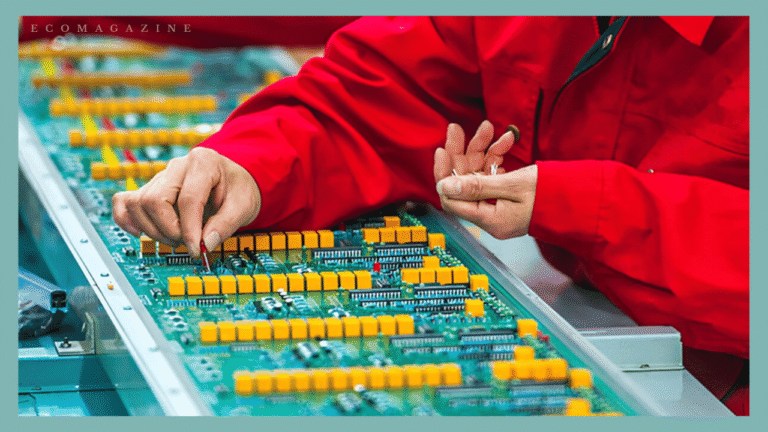In modern electronics, where high power and compact design are key priorities, Metal Core PCB technology has become a fundamental part of efficient circuit design. These printed circuit boards are engineered specifically to manage heat effectively, making them ideal for LED lighting, automotive, power supply, and industrial control systems. Unlike conventional PCBs that rely on epoxy resin or fibreglass substrates, Metal Core PCBs incorporate a metal base—usually aluminium, copper, or an alloy—that offers superior thermal conductivity and mechanical stability.
What is a Metal Core PCB?
A Metal Core PCB (MCPCB) is a type of printed circuit board that features a metal base layer designed to improve heat dissipation. It typically consists of three layers — a metal base (for thermal conduction), a dielectric layer (for insulation), and a copper circuit layer (for electrical connections). The metal base acts as a heat sink, drawing heat away from critical components such as LEDs, power amplifiers, and transistors.
This unique construction helps to keep electronic components cool and stable, even when operating under high power or continuous loads. By managing heat effectively, Metal Core PCBs extend the lifespan and reliability of the overall system.
Structure and Materials Used in Metal Core PCB
The structure of a Metal Core PCB is designed for durability, heat resistance, and optimal performance. It generally includes:
- Metal Base Layer: This layer is made from aluminium, copper, or a blend of metal alloys. Aluminium is the most popular due to its cost-effectiveness, excellent heat transfer, and light weight. Copper bases are used in high-performance applications where maximum thermal conductivity is required.
- Dielectric Layer: This is a thin layer of thermally conductive but electrically insulating material that transfers heat from the copper layer to the metal base. The thickness and thermal conductivity of this layer directly affect the board’s performance.
- Copper Circuit Layer: The top layer, made of copper foil, forms the circuit patterns that conduct electrical signals. The copper thickness can range from 1 oz to 6 oz depending on current and thermal requirements.
Advantages of Metal Core PCB
The growing use of Metal Core PCBs across industries stems from their numerous benefits compared to standard FR-4 boards.
- Excellent Heat Dissipation: The metal base efficiently transfers heat away from the components, preventing overheating and ensuring consistent performance.
- Improved Durability: Metal Core PCBs are more rigid and resistant to physical stress, making them ideal for environments with vibration or mechanical shock.
- High Thermal Conductivity: The thermal conductivity of aluminium or copper allows components to operate at lower temperatures, extending their operational life.
- Dimensional Stability: These boards maintain their structure and performance even in high-temperature conditions.
- Enhanced Power Handling: They can support higher power densities, making them ideal for LED lighting and power electronics.
Applications of Metal Core PCB
Metal Core PCBs are used in a wide range of applications where efficient heat management is critical. Their ability to maintain stability under high thermal stress makes them indispensable in the following sectors:
- LED Lighting: Used in high-power LED modules to prevent overheating and maintain brightness over time.
- Automotive Electronics: Integrated into headlights, power converters, and motor controllers that generate significant heat.
- Power Supplies: Essential for high-current power converters and voltage regulators to ensure reliable performance.
- Telecommunication Equipment: Supports RF amplifiers and base stations that operate continuously under heavy loads.
- Industrial Control Systems: Ideal for motor drives, sensors, and heavy-duty machinery that require high thermal stability.
Design Considerations for Metal Core PCB
Designing an effective Metal Core PCB requires a detailed understanding of both thermal and electrical performance. Engineers must carefully balance these factors to achieve optimal results.
- Material Selection: Aluminium is preferred for general-purpose applications due to its light weight and cost efficiency, while copper is chosen for high-performance circuits.
- Thermal Path Optimisation: Proper placement of components and vias ensures efficient heat transfer to the metal core.
- Dielectric Thickness: A thinner dielectric layer improves thermal transfer but must still provide adequate insulation to prevent electrical breakdown.
- Surface Finishes: Common finishes include HASL, ENIG, and OSP, chosen based on solderability and component compatibility.
Manufacturing Challenges of Metal Core PCB
While Metal Core PCBs offer superior performance, their manufacturing process requires high precision and advanced technology. The challenges typically include:
- Drilling and Plating: Metal cores are harder to drill and require special equipment to avoid tool wear and ensure accuracy.
- Layer Bonding: Achieving strong adhesion between the metal base, dielectric, and copper layer is essential for reliability.
- Thermal Expansion Management: The different expansion rates of copper, dielectric, and metal base must be managed to prevent delamination.
- Surface Planarity: Ensuring a smooth surface for component mounting is crucial, particularly for automated assembly processes.
The Future of Metal Core PCB Technology
The demand for Metal Core PCB technology continues to rise, especially with the global growth of energy-efficient systems, electric vehicles, and high-brightness LED lighting. Advancements in materials and fabrication methods are leading to thinner, lighter, and more efficient designs. Hybrid Metal Core PCBs, which combine metal and ceramic substrates, are emerging to achieve even greater thermal and electrical performance.
With environmental concerns driving energy efficiency, industries will continue to adopt Metal Core PCBs for applications requiring both performance and sustainability. Manufacturers are focusing on refining dielectric materials and surface finishes to enhance heat transfer and reduce energy loss.
Conclusion
In summary, Metal Core PCB technology provides an excellent solution for high-power applications where heat management, reliability, and durability are crucial. Its superior thermal conductivity, mechanical strength, and long-term stability make it an ideal choice for industries such as automotive, lighting, power, and communications.
For companies seeking dependable and cost-effective solutions, partnering with an experienced Metal Core PCB Supplier ensures access to advanced materials, precision manufacturing, and consistent product quality tailored to meet diverse industrial requirements.


